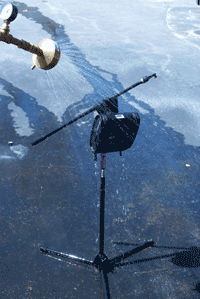 Tony Revis (pictured), general manager, Extech Data Systems, offers advice on choosing portable printers to complement mobile computing solutions.
Tony Revis (pictured), general manager, Extech Data Systems, offers advice on choosing portable printers to complement mobile computing solutions.
Across the business spectrum, regardless of industry, the successful workforce manager has taken full advantage of the growing trend in technology that has allowed the employee base to operate efficiently while on the go. Mobile computing systems have evolved to become an integral part of the supply and delivery chain, and companies who have failed to utilize the wealth of available mobile accessories may soon find themselves left in the dust.
From field service and sales or route accounting, to ticketing or data collection, mobile computing succeeds in alleviating much of the legwork and inefficiency that can result from hand-written methods. Of course, mobile computing applications are rarely limited to a data-collecting terminal alone. On the contrary, a vast number of these systems include a portable printing device to provide tangible output for the customer. Sales records, invoices, and receipts are just some of the examples of applications in portable printing.
Selecting the proper portable printer is largely dependent on the specific application the user intends to employ. However, regardless of application, users should invariably seek several characteristics indicative of a quality portable printer. An economical and durable unit should always maintain functionality in both an outdoor and an indoor environment. The printer should maintain a compatibility with most mobile computing terminals, and hold a battery charge for an extended period of time.
But what about product safety? Users need to consider the resilience of the unit when selecting a mobile printer. It is important not only to consider the functional safety of a printer, but to consider a units overall efficacy as well. While portable printers are not used in the home in the sense of a traditional desktop printer, they are often brought into homes and used when the application calls for tangible output for the customer. Even more often, technicians or salespeople charge the printers in their homes at the end of the workday. For these reasons, it is important that portable printers meet many of the same certifications as products that are certified for consumer use. When a company takes product safety and product certification to the highest level, everyone in the delivery chain wins.
 Portable printing requirements: background
Portable printing requirements: background
The European Committee for Electro Technical Standardization has developed the most comprehensive set of guidelines to which portable printers should adhere. Ingress Protection (IP) Ratings specify the environmental protection that an enclosure provides from both solid debris and liquids. IP certification is most effectively used as a supplement to existing IEC 68 certification, which certifies operating and storage temperature, humidity, shock, vibration, and drop to concrete.
With an IP rating of at least 54, customers can be sure that the printer is highly resilient against moisture and dust penetration. In order to secure such a rating, manufacturers must take great care in ensuring that the printers are equipped with rugged environmental cases. Even the smallest crack or crease in a printers casing can allow harmful pollutants to inhibit unit functionality.
While IEC 68 is the standard utilized in portable printer compliance, IP is merely a loose guideline rather than a regulated standard. Portable printing units are not required to act in accordance with both criteria simultaneously, however. If a printer is found to be compliant with either IEC 68 or IP certifications, it is deemed satisfactory and sufficient for distribution on the market.
Qualities to look for in a mobile printer
Customers are justified in researching printers from an economic standpoint, as well as from a durability standpoint. Making an informed decision regarding which portable printing unit is ideal for a specific application includes seeking a unit with a suitable price tag without compromising environmental toughness and safety as a result.
Almost all portable printers on the market adhere to either the IP or IEC 68 standards, but a select few maintain complete compliance with both. Even fewer are ETL listed and conform to ANSI/UL STD 60950. Finally, only the most versatile and durable printers on the market are certified to CAN/CSA STD C22.2 No. 60950-00. Because printers are only required to meet the terms of one of the above standards, quality and durability can be sacrificed at the hands of cost in many of the portable printing units available for purchase.
And buyer beware: When evaluating any product for use, look closely at the wording of certifications. Some manufacturers say that they meet certain ratings; for example, built to xyz standards. This claim, however, rarely means that the product is certified, particularly in the world of mobile printers. The truth is that very few manufacturers subject their printers to the rigorous testing and certification processes to achieve full compliance with all of the aforementioned regulations. In order to be sure that you are specifying the most valuable printing option possible for your application, it is important to ensure that valid certification is given to your products.
Quality standards in practice
With the bevy of portable printers failing to adhere to the suggested guidelines set forth for consumer use ruled out, the once seemingly convoluted portable printing market becomes significantly less complex. Qualifying a printer by the price tag is a mistake that consumers often make once the unit is applied in action.
Imagine a company whose workforce is largely dictated by practice in the field, where the functionality of a printer may make the difference between a worker completing a job or leaving a task unfinished. Police departments, for instance, are among the largest users of portable printers, and the nature of the work is one that often requires the workforce to carry out responsibilities in unfavourable outdoor environments. A printer that is not able to withstand adverse weather conditions while maintaining functionality will inevitably bar the user from fulfilling seemingly elementary work practices, particularly in parking and traffic applications.
For this reason, all printers should be designed for both indoor and outdoor use, with the utmost priority placed on unit protection to ensure operation in areas of high moisture and dust. Workforces in the fields of distribution, supply chain, and POS all rely on the dependability of mobile computing devices under environments of extreme duress. Buying from a manufacturer that produces portable printing units in compliance with those important standards means that your workforce will be utilizing a printing unit with the highest resiliency against temperature range, shock and vibration, and drop.
As the efficiency of the mobile workforce continues to influence the welfare of business operations, managements best practices will always include the furnishing of the employee base with suitable and reliable equipment to expedite worker output. While the proper portable printer proves to be a valuable tool in the completion of mobile workforce activities, a printing unit that fails extensive product certification can easily impede a capable mobile workers efficiency. While it may seem that very few factors differentiate one mobile printer from another, the truth remains that the units reliability may ultimately dictate a workforces functionality. For this reason, it is imperative to research a portable printers product certification standards.
Tony Revis is general manager of Extech Data Systems, a division of Extech Instruments, one of the worlds leading developers of portable printers for enterprise-wide applications centred around mobile information and remote transactions. The company designs, develops and markets portable printer products, and sells its products worldwide through a global network of distributors and marketing partners.

Add a Comment
No messages on this article yet